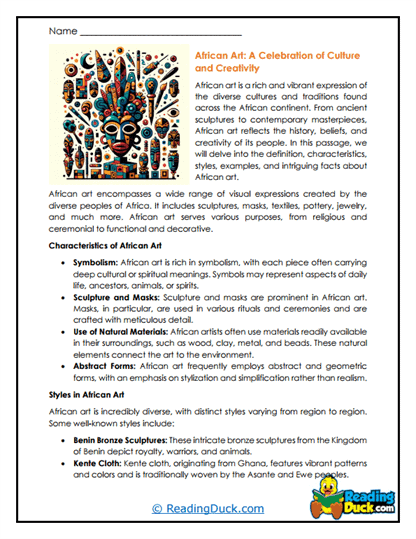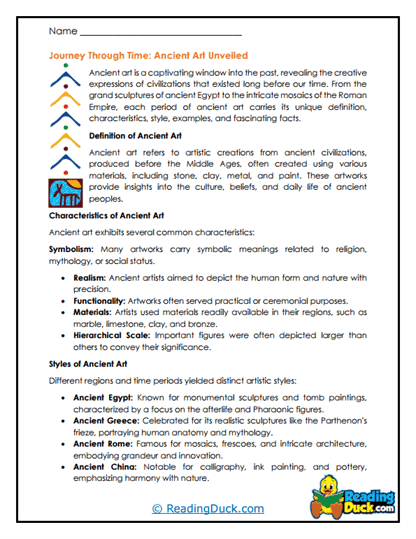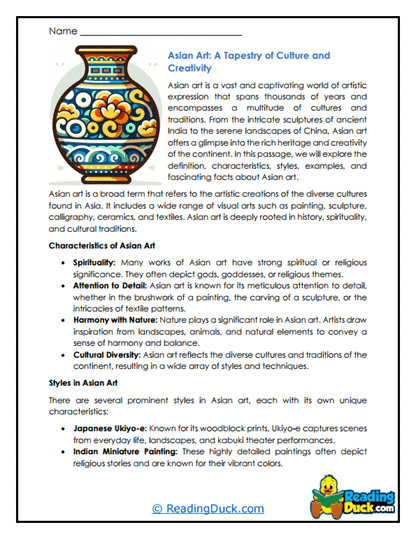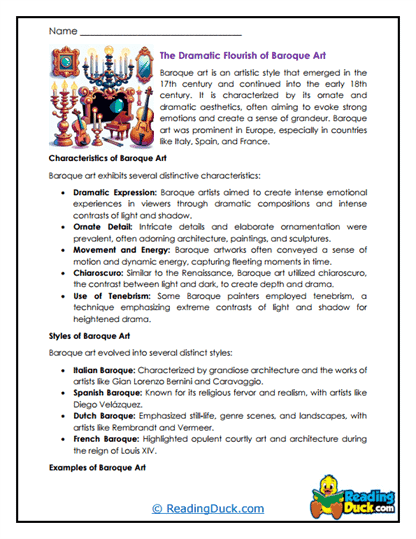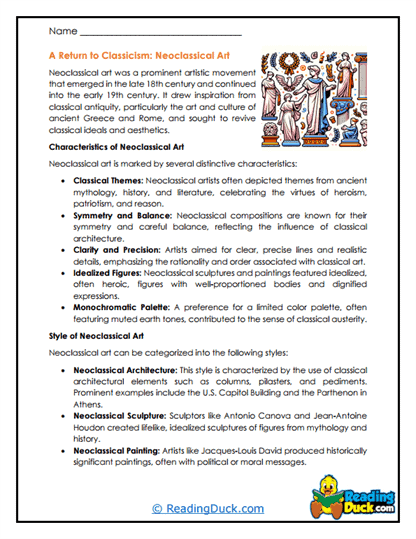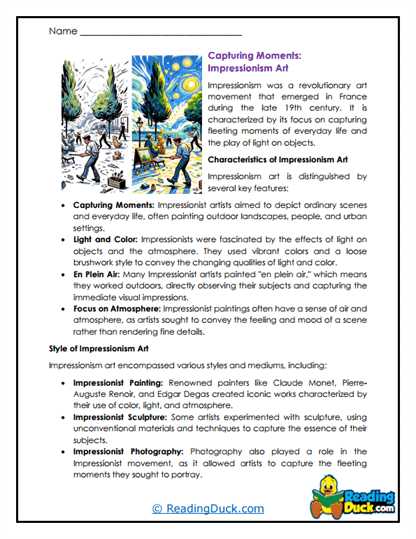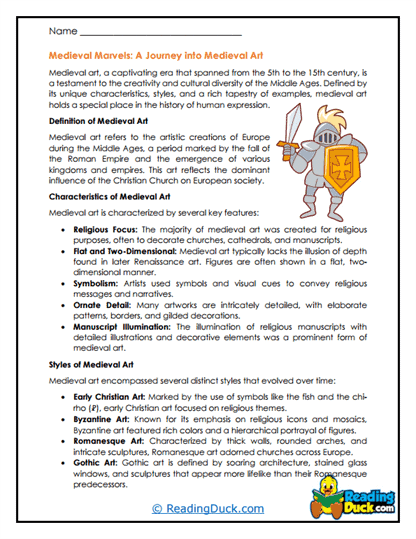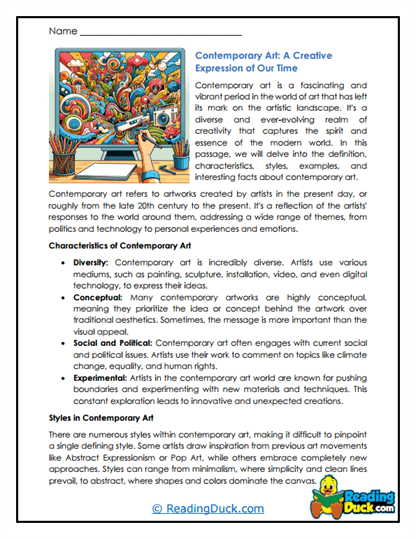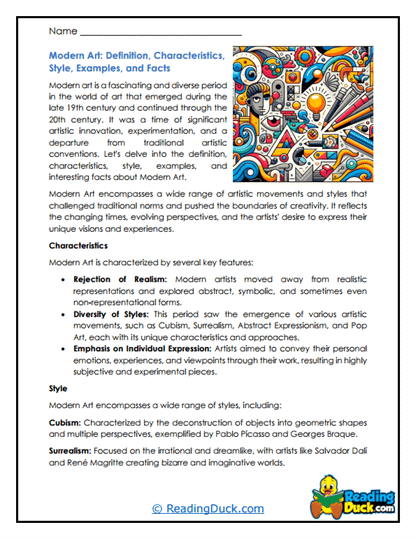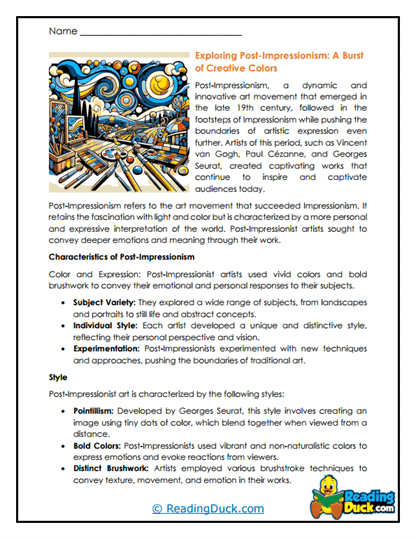Art History Worksheets
About Our Art History Worksheets
Our Art History Worksheets offer students a comprehensive exploration of the rich and varied history of art, from ancient civilizations to modern movements. These worksheets are designed to engage students in understanding how art has evolved over time and how it reflects the cultural, social, and political contexts of different periods.
Each worksheet set includes:
- Multiple Choice Questions: These questions assess students' comprehension of the reading passages, focusing on key details, artistic movements, and the significance of specific artworks or artists.
- Short Answer Questions: Students are prompted to provide concise responses, summarizing important information, analyzing artistic techniques, and reflecting on the impact of art throughout history.
- Open-Ended Questions: These questions encourage students to think critically and express their personal interpretations, opinions, and preferences regarding various art movements, allowing for deeper engagement with the material.
These worksheets help students demonstrate their understanding of art history and foster a meaningful connection to the subject matter. An answer key is provided for each question sheet, making it easy for teachers and parents to evaluate student progress. The worksheets are available in PDF format, ensuring they can be easily viewed electronically, downloaded, and printed.
The Evolution of Art: A Journey Through Time
Art history is a fascinating and complex subject that chronicles the evolution of human creativity and expression over the centuries. By studying art history, students gain insight into how art has served as a reflection of societal values, political ideologies, and cultural shifts. Understanding art history is essential for appreciating the diverse ways in which humans have communicated ideas, emotions, and beliefs through visual media.
Students exploring art history will delve into several key aspects:
- Artistic Movements and Periods: Art history is divided into various movements and periods, each characterized by distinct styles, techniques, and themes. From the classical art of ancient Greece and Rome to the avant-garde experiments of the 20th century, students will learn how each movement reflects the values and concerns of its time.
- Influential Artists and Their Works: Throughout history, certain artists have left an indelible mark on the world of art, shaping the course of artistic development. Students will explore the lives and works of these influential figures, from Leonardo da Vinci and Michelangelo during the Renaissance to Pablo Picasso and Jackson Pollock in the modern era.
- Cultural and Historical Contexts: Art does not exist in a vacuum; it is deeply influenced by the cultural and historical contexts in which it is created. Students will examine how art has been shaped by major events such as wars, revolutions, and social movements, and how these events have been depicted in art.
- Techniques and Materials: The study of art history also involves an exploration of the techniques and materials used by artists throughout the ages. From the frescoes of the Renaissance to the digital art of today, students will gain an understanding of the diverse methods artists have employed to bring their visions to life.
- Themes and Symbolism: Art is rich with symbolism and themes that convey deeper meanings and messages. Students will investigate how artists use symbols, allegories, and themes to express complex ideas, emotions, and narratives.
- Global Perspectives: While much of traditional art history has focused on Western art, it is important to include a global perspective, exploring the rich artistic traditions of non-Western cultures. Students will gain an appreciation for the diversity of artistic expression around the world, from African tribal art to the intricate designs of Islamic architecture.
Through the study of art history, students will not only develop an appreciation for the visual arts but also gain a deeper understanding of the broader cultural and historical forces that have shaped human civilization.
How Teachers and Parents Can Integrate These Worksheets in a Learning Curriculum
Integrating the study of art history into a learning curriculum can be both educational and inspiring for students. Here are some practical ideas for using these worksheets in the classroom or at home:
- Create a Chronological Timeline: Use the worksheets to help students create a timeline that traces the development of art from ancient times to the modern era. This activity can help students visualize the progression of artistic movements and how they have influenced one another.
- Connect Art with History: Integrate the study of art history with history lessons, showing how artistic developments were often influenced by historical events, such as the Renaissance following the Middle Ages or the rise of modernism after World War I. This cross-disciplinary approach can deepen students' understanding of both subjects.
- Group Projects and Presentations: Encourage students to work in groups to research a particular art movement or artist, using the worksheets as a foundation. They can then present their findings to the class, fostering collaboration, research, and public speaking skills.
- Art Replication Exercises: After learning about specific techniques and styles from the worksheets, have students create their own artwork inspired by historical movements. This hands-on activity helps students connect with the material in a tangible way and allows them to explore their creativity.
- Field Trips or Virtual Museum Tours: If possible, organize field trips to local museums or art galleries to see original artworks that relate to the content of the worksheets. Alternatively, use virtual tours of famous museums to provide context and make the subject matter more relatable and engaging for students.
- Supplemental Homework Assignments: Use the worksheets as supplemental homework assignments to reinforce in-class learning. Students can complete the reading passages and questions at home, allowing for more in-depth exploration of the topic.
- Incorporate Technology: Encourage students to use online resources to research additional information about art history. They can explore virtual museum exhibits, watch documentaries, or create digital presentations to complement the worksheets.
- Adapt to Different Learning Levels: Tailor the complexity of the worksheets to suit different grade levels. For younger students, focus on basic concepts and simpler art forms, while older students can handle more detailed analyses of artistic techniques and historical contexts.
Studying art history through these worksheets can enhance students' critical thinking, analytical, and interpretative skills. By engaging with the evolution of art, students develop a greater appreciation for cultural diversity and historical significance, which are essential for their overall academic and personal growth. These skills not only contribute to success in the classroom but also foster a lifelong interest in history and the arts, encouraging students to explore and appreciate the world around them.
